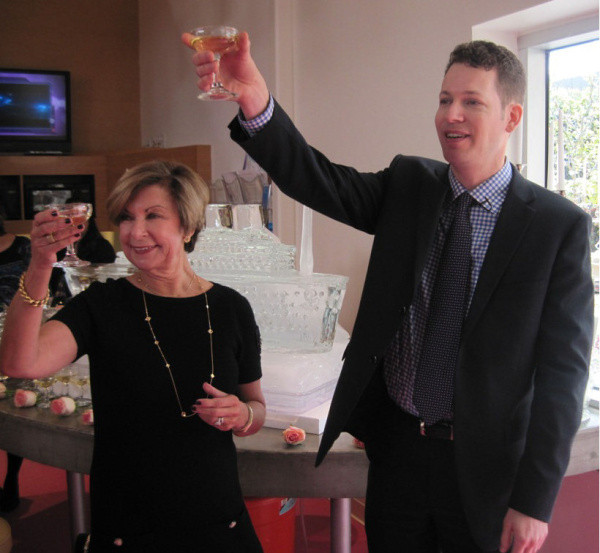Kevin Jones 20th Anniversary Interview
On November 15, 2019, Curator Kevin Jones celebrated his 20th year at the FIDM Museum! To mark this milestone, we asked our social media followers what questions they had for Kevin about his career and experiences in the field over the past twenty years. Read on to learn what missed acquisition keeps him up at night, which costume was the most difficult to mount, and where he hopes to see the Museum in twenty years.
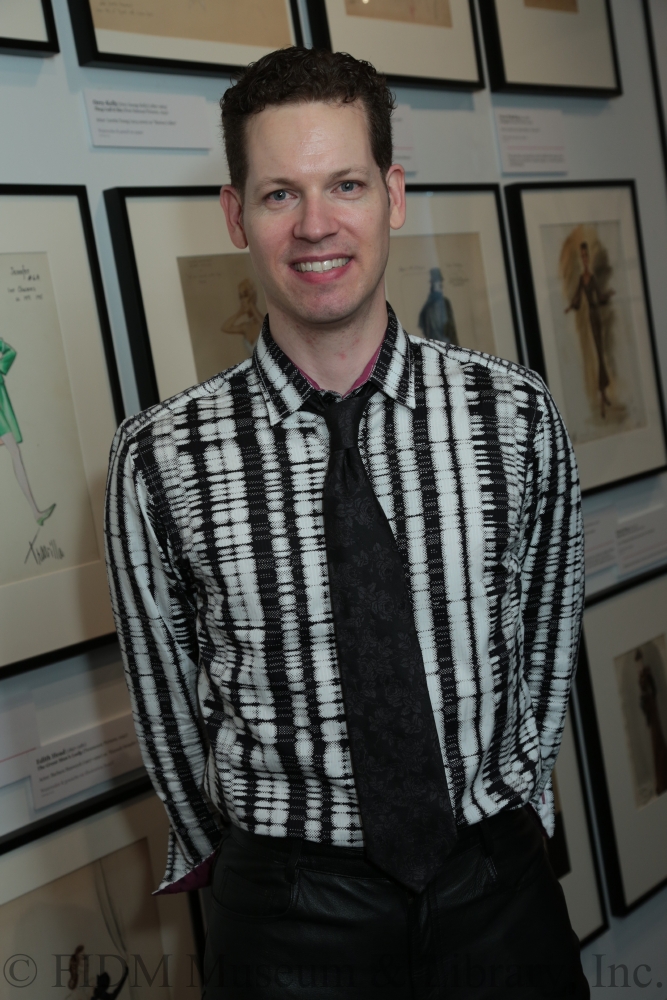 Kevin at the opening of Designing Hollywood: Sketches from the Christian Esquevin Collection, 2014
Kevin at the opening of Designing Hollywood: Sketches from the Christian Esquevin Collection, 2014
This was asked by several people: what is your favorite object in the collection?
That is so impossible to answer because there are too many - every time I open a box I say 'this is my favorite'! Obviously, the McQueen peacock dress, because truly that would not have existed had the Museum not commissioned it, so that’s something I’m really proud of. One of the historic garments that I love is the 1883 Vanderbilt ball fancy dress that was worn by Emily Vanderbilt Sloane. Normally I’m not interested in costume because I like the fashions that people wore in the day, but that was a pivotal moment in New York history, the development of architectural styles in the United States, the social atmosphere of the 400 and the high society of the Gilded Age. It’s believed that ball was the moment the Vanderbilts entered society. The gown was made in New York and has somehow survived in extraordinary condition - it looks like it stepped out of the photograph that exists of Emily wearing it. That’s something that was fun to acquire.
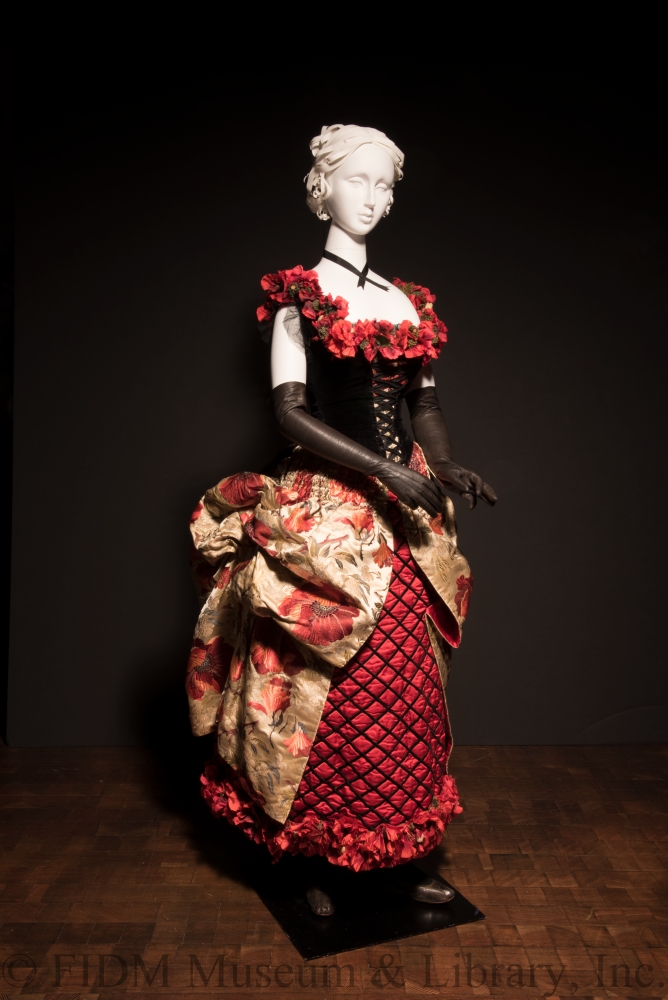 Vanderbilt fancy dress costume 1883, New York FIDM Museum Purchase 2012.5.32A-C
Vanderbilt fancy dress costume 1883, New York FIDM Museum Purchase 2012.5.32A-C
 Installing Modern Love at the Bendigo Art Gallery, Australia, 2013 Alexander McQueen peacock dress, Fall/Winter 2008-9 (commissioned 2010) FIDM Museum Purchase: Funds generously provided by Karen Coombs-Jordan 2010.5.73
Installing Modern Love at the Bendigo Art Gallery, Australia, 2013 Alexander McQueen peacock dress, Fall/Winter 2008-9 (commissioned 2010) FIDM Museum Purchase: Funds generously provided by Karen Coombs-Jordan 2010.5.73
Another popular question: who in your opinion is the greatest designer in fashion or film, living or dead?
There’s no way! I love all the biggies, like Dior. Vionnet - when you examine her work, not only is it aesthetically beautiful when you step away from it, but the closer you get to it the more beyond phenomenal it becomes. I’m really a 19th century guy, and so many of the wonderful garments that survive from the 19th century have no designer attributions. I love Pingat because he did a lot of surface treatments; I particularly love embroideries. I love Paquin. We just acquired a Natalia Goncharova evening coat - the workmanship is beautiful, but it's more the concept of the coat that makes it stand apart and just is mesmerizing to me. I truly loved Alexander Mcqueen's work because he respected dress history. He also immersed himself in every aspect of the technical construction of garments before he became famous. Hollywood Costume Designers…I do love Walter Plunkett because I’m fascinated by his use of history. Who couldn’t love Adrian? He transitioned; he was Hollywood and then became a fashion designer. You could see his design, his style, his aesthetic translated onscreen and off-screen. I think that is an amazing feat to do - he knew how to translate the overblown, oversized, over-glamorized designs of what was needed onscreen to real women’s wardrobes.
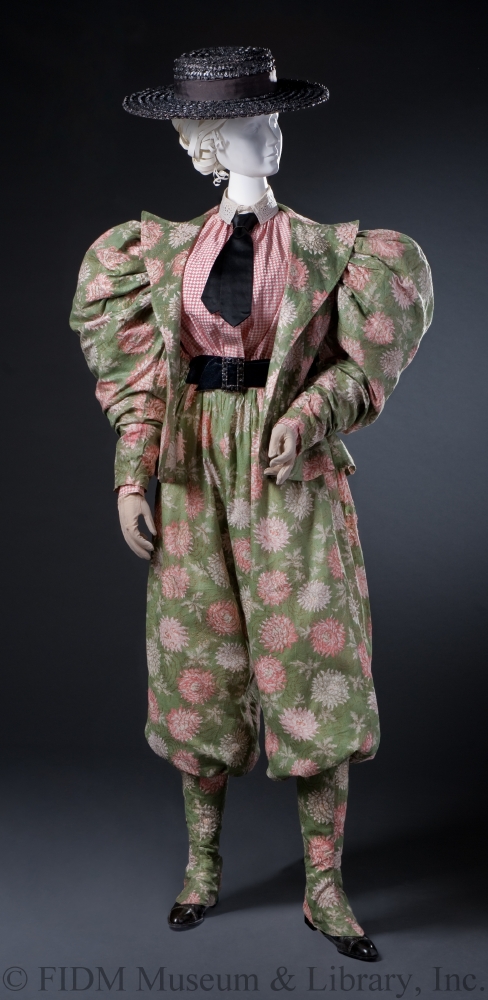
Cycling ensemble, c. 1895 Gift of Steven Porterfield 2014.897.25A-D
What is the acquisition you’ve been most excited about?
I didn’t even find it, but I’ll take credit for accepting it into the museum! It’s the c. 1895 floral print four-piece bloomer cycling ensemble. It is so rare, and I always wanted a bloomer cycling ensemble from the 1890s. Steven Porterfield, a dealer out of Texas and one of our great champions of the Museum, bought it for us. He called me and said “I’m sending you a box of something that’s really strange.” The box arrived, I opened it up and looked in and I thought... what is this? The fabric is olive green with great big pink chrysanthemums, and printed over them are outlines of chrysanthemums in copper metallic. I knew it was definitely 1890s fabric because that period was really in your face. Then I picked up the jacket and the sleeves are eight feet wide, just these massive, humongous, leg o’ mutton sleeves! What is this thing?? I put the jacket on the dress form and it was crazy. Then I looked in the box and there were more pieces to it. I picked up one of the gaiters and realized it was a cycling ensemble. I thought, oh please oh please oh please let this be bloomers, it’s fine if it’s a skirt but please let it be bloomers! I lifted it up and there were the bloomers. To have this four-piece matched outfit is truly incredible. That really is one of the most extraordinary acquisitions, and I can’t even take credit for it! Also, the cumulative grouping of acquiring the Helen Larson Historic Fashion collection. Not only is it filled with beautiful pieces, but it was transformative for the Museum, and it was a seven year fundraising project with our Fashion Council. The fact that we got to cherry pick the finest pieces, including royal objects. It’s not just the provenance, because we collect things that are phenomenal design, but the fact that we can place them in very important events worn by important people in history is astounding - it’s an added bonus. I love Princess Charlotte and that’s one of my absolute favorite pieces. And all of the other 350 plus items that we ended up getting from that collection is something I’m really proud of.
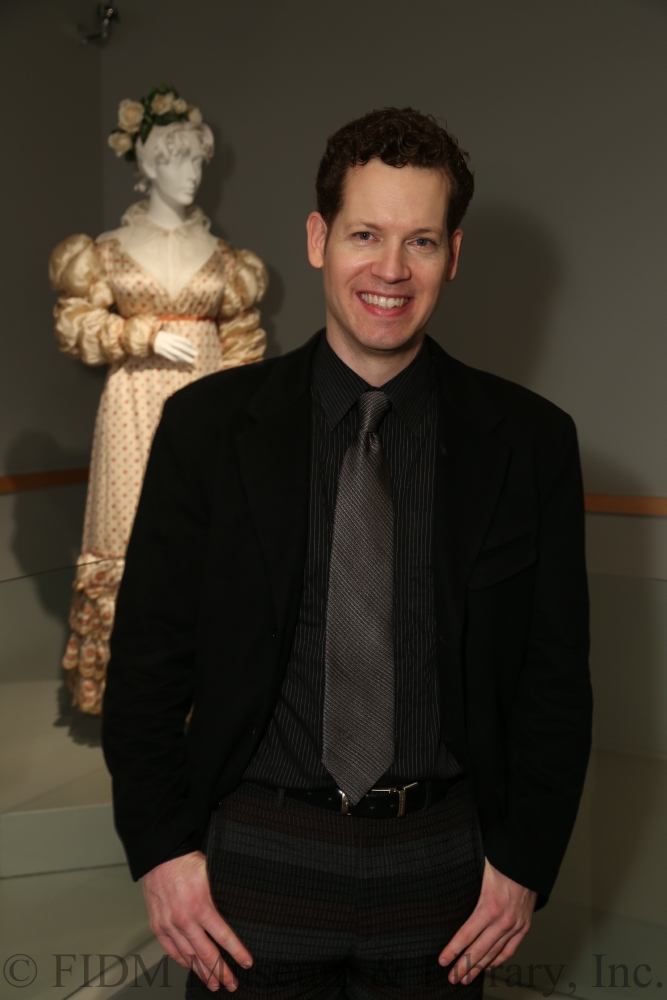 Kevin with his beloved printed silk gown worn by Princess Charlotte, 1816-1817 Helen Larson Historic Fashion Collection FIDM Museum Purchase: Funds raised by the FIDM Museum Fashion Council [2011-2015] and other generous donors 2017.5.40
Kevin with his beloved printed silk gown worn by Princess Charlotte, 1816-1817 Helen Larson Historic Fashion Collection FIDM Museum Purchase: Funds raised by the FIDM Museum Fashion Council [2011-2015] and other generous donors 2017.5.40
If by magic you could add any piece to the collection, what would it be?
There is one, truly, and you’re going to be surprised! I would kill to find a mid-1860s knotwork swansdown mantle. These were full mantles that came out of Russia that were completely made of swansdown knotted into patterns. They’re just the most astounding things ever. To think of creating this mantle that would be lightweight and completely warm on those Russian nights sledding through the snow. I’ve never seen one available!
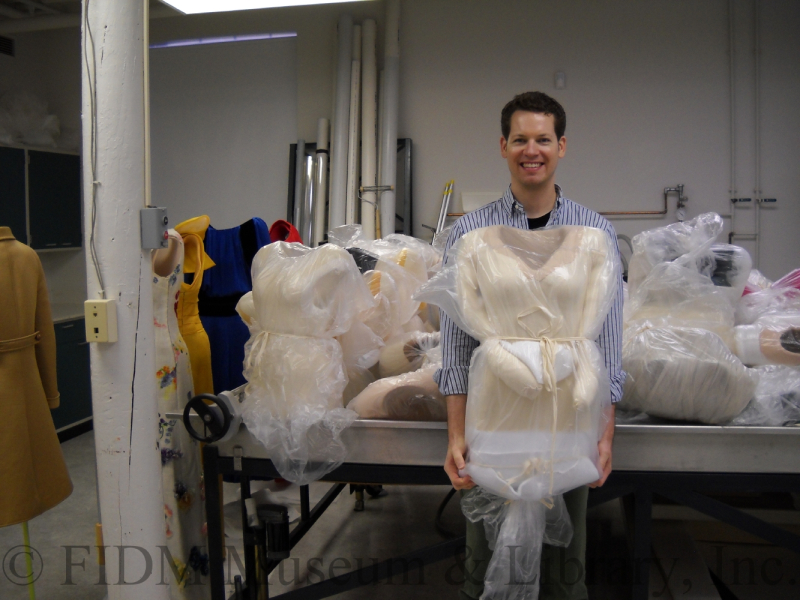 Surrounded by High Style dress mounts, 2009
Surrounded by High Style dress mounts, 2009
How do you find new pieces to acquire?
All over the place. I do a lot of searching online, there are all sorts of databases and online auction sites that I go to. I track some pieces in private collections that hopefully someday the owners will want to sell and we can pounce on them! Of course, there are the standard auctions that we all watch. I know lots of dealers, although the dealer world is shrinking, because a lot of the ones I knew 20 years ago are gone or retired. It’s a harder business.
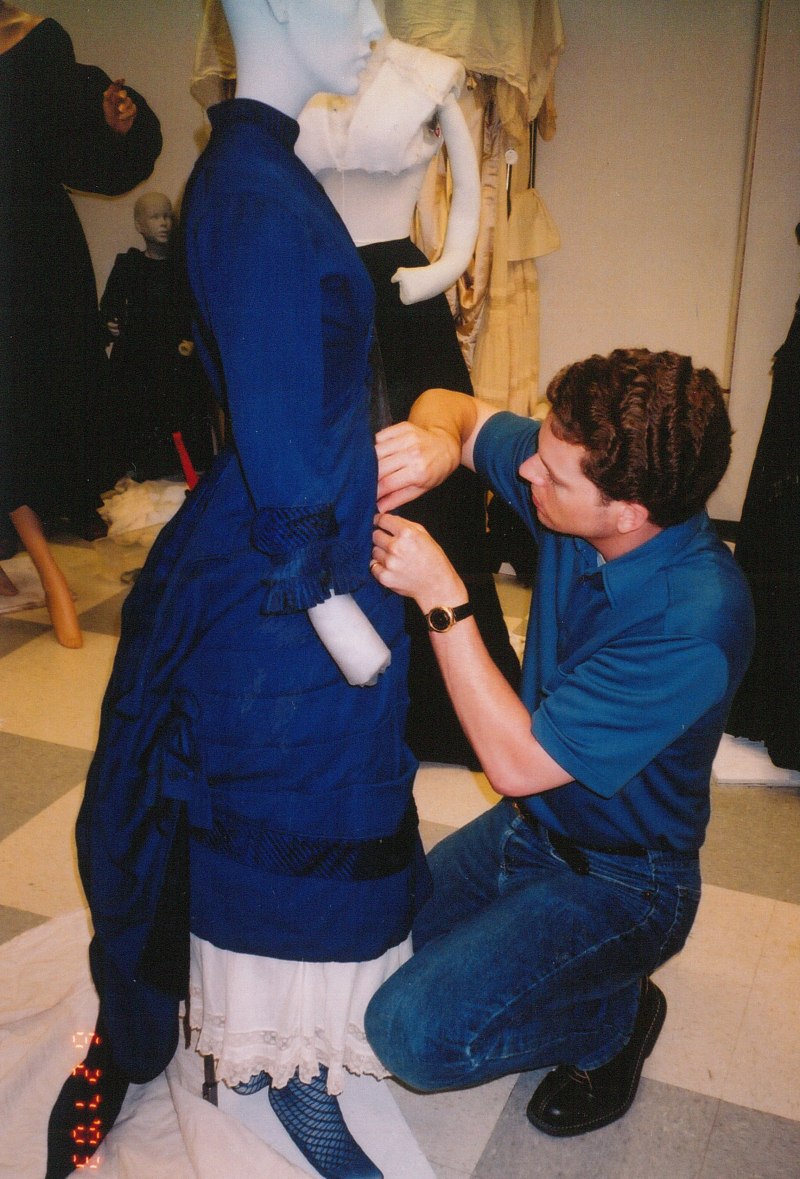 Dressing an 1870s ensemble, 2003
Dressing an 1870s ensemble, 2003
Do you have a bucket list of items you’d like to acquire for the Museum?
The bucket list items for me are now geared toward our exhibitions. For Sporting Fashion: Outdoor Girls 1800 to 1960, my bucket list was to find the things we needed for the exhibition so we could tell as full a story as possible. We succeeded, which is astounding given the rarity of so many of the pieces. Associate Curator Christina Johnson is working on the Rudi Gernreich exhibition. While we have the Gernreich Archive, one of the things we’re trying to do is acquire his early pieces from the fifties. Christina and I both want to do a couture exhibition for the upcoming 50th anniversary of the FIDM Museum. We want to do the first 50 years of the haute couture, so the 1860s to the 1910s. Literally from day one I have been searching for couture pieces. So the bucket list items are the things to fulfill exhibition needs. Of course, once in a while, something comes along that we just need to acquire because we have the opportunity to do so.
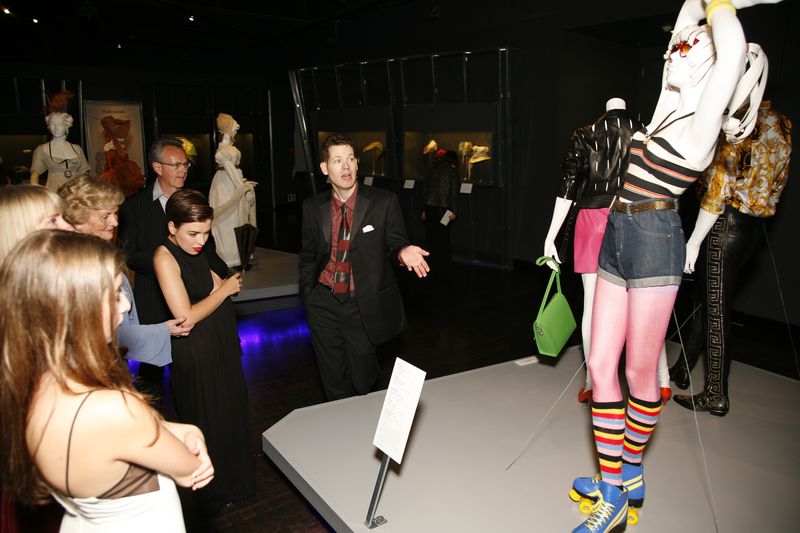 Leading a tour of the FABULOUS! exhibition, 2011
Leading a tour of the FABULOUS! exhibition, 2011
Is there an item that you’ve missed out on that still keeps you up at night?
Every single item that I have not acquired has haunted me for years! Actually, one thing does come to mind, a pair of Adrian shoes. I had never seen a pair of Adrian shoes and I’ve never seen another pair available. So that has always bugged me. I know where they are, and the private collector who has them has promised them to us...I hope he remembers that!
What school did you attend and what did you study?
I went to FIDM and I studied fashion design, but I never wanted to be a designer. I'm so glad I came here - and graduated 4.0, I’m happy to say - because it’s helped me a great deal to understand what I’m looking at with historical garments. The background in patterning, draping, fashion design, production, all of that is fantastic knowledge to have to do what I do with our garments. And then I went on to UCSB and got my Bachelors in Art History to combine my two loves together.
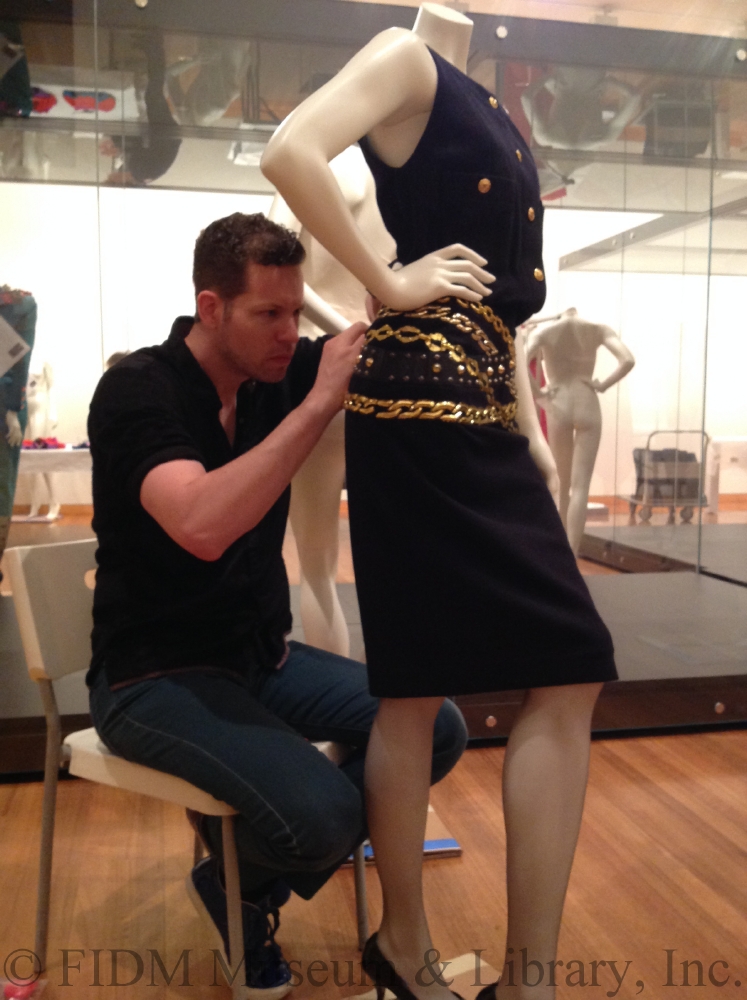 Putting the finishing touches on a Karl Lagerfeld for Chanel dress in the Modern Love exhibition at the Bendigo Art Gallery, Australia, 2013
Putting the finishing touches on a Karl Lagerfeld for Chanel dress in the Modern Love exhibition at the Bendigo Art Gallery, Australia, 2013
What was your interview process like for this job?
A position of Collections Manager opened up here. I made an appointment through the previous curator to meet with the director…and I got here 45 minutes late because of traffic! It was bad. I even called to say maybe I shouldn’t come in, but I was encouraged to still come even though I was late. I guess it wasn’t held against me, because I did get the job! I was Collections Manager for two and a half years before becoming curator.
Was it always your goal to become a curator?
It was definitely something that I was interested in. I didn’t think it would happen quite so fast! I was in the right place at the right time at the right institution. It was a good fit. I probably wouldn’t have been selected at a larger institution where there’s a lot more hierarchies and hoops to jump through.
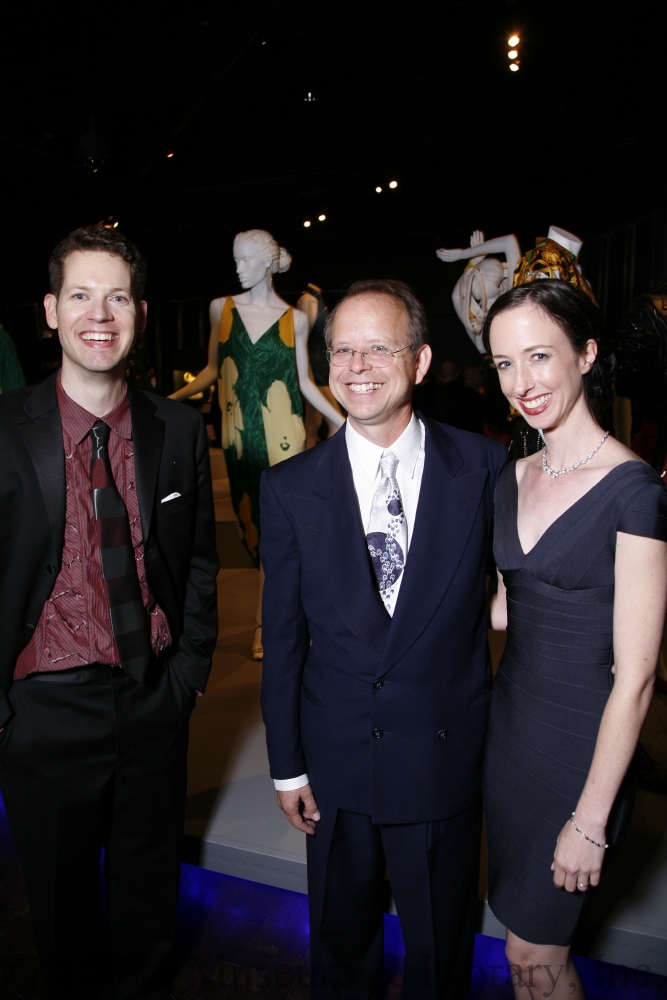 Kevin, vintage dealer Steven Porterfield, and Associate Curator Christina Johnson at the opening of FABULOUS!, 2011
Kevin, vintage dealer Steven Porterfield, and Associate Curator Christina Johnson at the opening of FABULOUS!, 2011
What has been the most difficult costume or ensemble to mount?
This was epic - I wish we had it filmed! In 2003 we had the costumes from Lord of the Rings: The Two Towers. We had Viggo Mortensen’s suit of armor for Aragorn. These costumes arrive and they don’t have instructions, you have to look at stills or watch the film, and also have experience in dressing armor. I swear it had 80 pieces to it, it was just layer upon layer upon layer, dressing on a mannequin that is static. There was a knit undersuit too which makes everything even worse. A former colleague and I were down in the gallery to dress this outfit. The mannequin is over six feet tall, it’s incredibly heavy because of the layers of knit and mesh and cloaks. Oh and by the way, in movies to make things look gross they use KY Jelly - so it was KY Jelly coated armor that had all this dirt and debris from filming! It took hours to get these things on and we’re covered in KY Jelly, dirt, sweat, frustration. We get it dressed and we go to move it...and one of the arms popped out. And I literally sat down on the platform and was on the verge of just losing it! My colleague was so fabulous, I don’t know how she did it but she got the arm back in. That armor was very memorable.
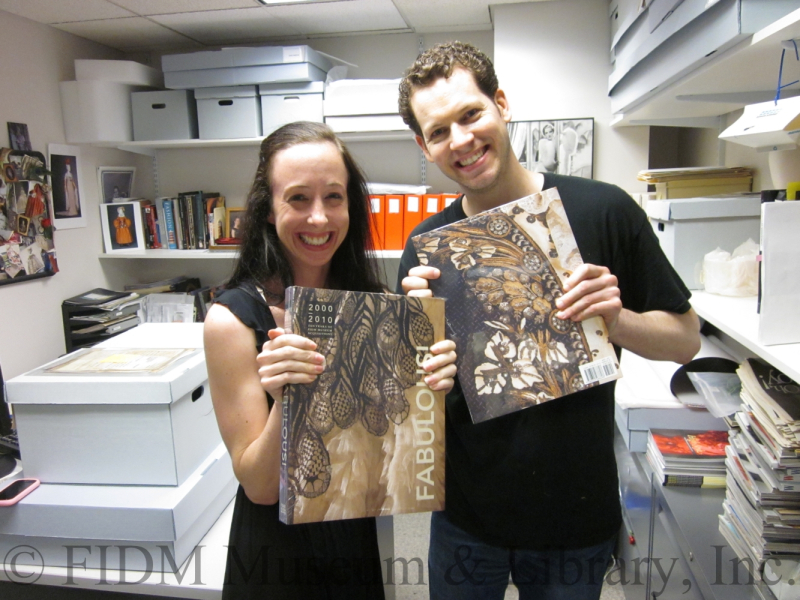 Christina and Kevin with the first copies of the FABULOUS! catalog, 2011
Christina and Kevin with the first copies of the FABULOUS! catalog, 2011
You are now working on your third catalog for the Museum. How has that process changed, and what have you learned?
Experience, experience, experience. The first catalog that Christina and I worked on was High Style: Betsy Bloomingdale and the Haute Couture; it’s a small catalog, but it’s charming and we’re proud of it. We jumped to the FABULOUS! catalog which was huge, and that’s because we had an idea of how to do a catalog now - working with the designer, photography, research and writing. We went on steroids for FABULOUS! and I’m really proud of it. That was a great experience to know how to manage a multi-faceted project. Sporting Fashion has been much easier in my opinion because of what we learned. Knowing how to break up the research, the writing, the time it would take to do all of that. Sticking to a schedule. Staying up nights looking for images, looking at databases for period information, going through our Special Collections, looking at magazines, newspapers, and fashion plates. Continually searching for the objects! I could never have done this if it was my very first book. Also, the process of learning. I’m not a natural-born writer. I’m not one of those people who came out at birth with a quill in my hand! I have tried to learn from our previous two editing processes with this one, and I can definitely see improvements in my writing. I will always need a good editor, but that’s been a joy.
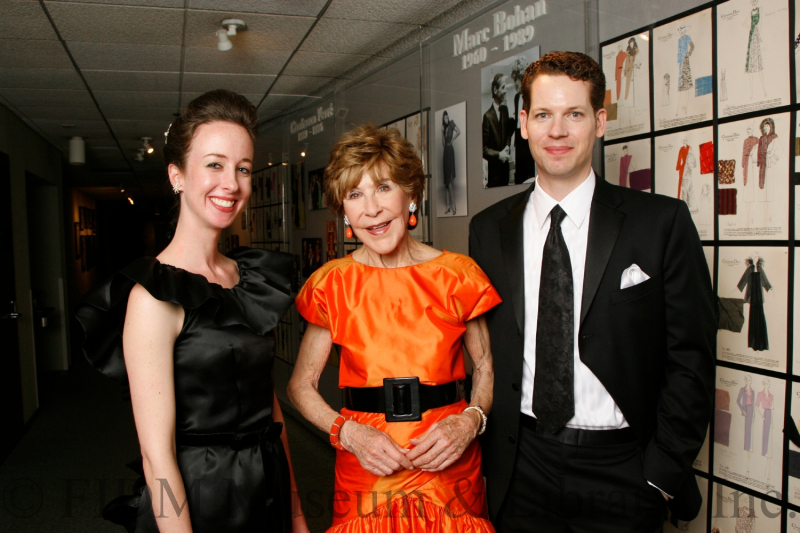 Christina and Kevin with Betsy Bloomingdale at the opening of High Style: Betsy Bloomingdale and the Haute Couture, 2009
Christina and Kevin with Betsy Bloomingdale at the opening of High Style: Betsy Bloomingdale and the Haute Couture, 2009
What is your proudest accomplishment over the past twenty years?
I think the success of the FIDM Museum Fashion Council has been something that I’m most proud of, and I can’t take the credit for it. The idea was there to have a support group because you cannot work in this field alone, you need so much help. To have somebody like Mima Ransom become a dear colleague and an even more dear friend because of the work here is something that means a lot to me. The fact that this group of people have been incredibly generous, talented, creative, and hard-working for the Museum - and they can see the benefits. The way our collections have grown and the objects we’ve acquired is a great tribute. I’m really proud that facet of the Museum has been developed.
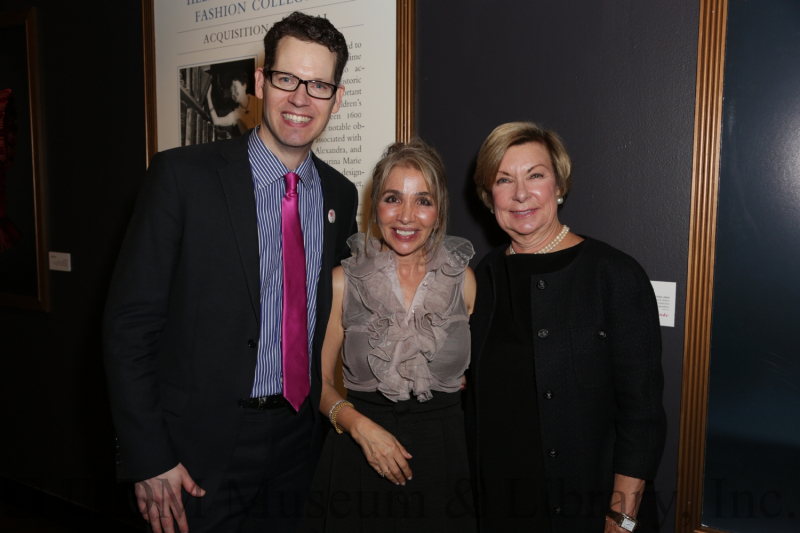 Kevin, Fashion Council Chair Mima Ransom, and FIDM Museum Director Barbara Bundy in 2013.
Kevin, Fashion Council Chair Mima Ransom, and FIDM Museum Director Barbara Bundy in 2013.
How has the field changed in the 20 years you’ve been at the Museum?
It’s become so much broader and bigger. There are more fashion museums than when I started. It’s so much more accessible because of the digitization of collections. The field has become more popular. The blockbuster exhibitions that have happened. It’s sad that it seems so much of it is blockbuster driven now. The idea to get your collection out there with publications, that’s something I feel. Also the education requirements. I was able to squeak in as maybe the last generation that did not need a PhD to get in, now it seems almost every single position definitely requires a Masters, and going onto PhD level. It’s fantastic, because the more education someone has the broader range they can bring to their institution and the better projects they can do. I’m really interested in the objects and that’s where I have shined for the FIDM Museum, to transform our collections that way. But now that I feel we are a museum that can hold our own with other like institutions, the lack of a Masters or PhD weighs on me because I feel like I'm not a good enough representation of the Museum. A future curator is going to be required to have a lot more education than I have. Not experience, because I have experience, which is its own education, but that fundamental foundation that gives the institution credibility.
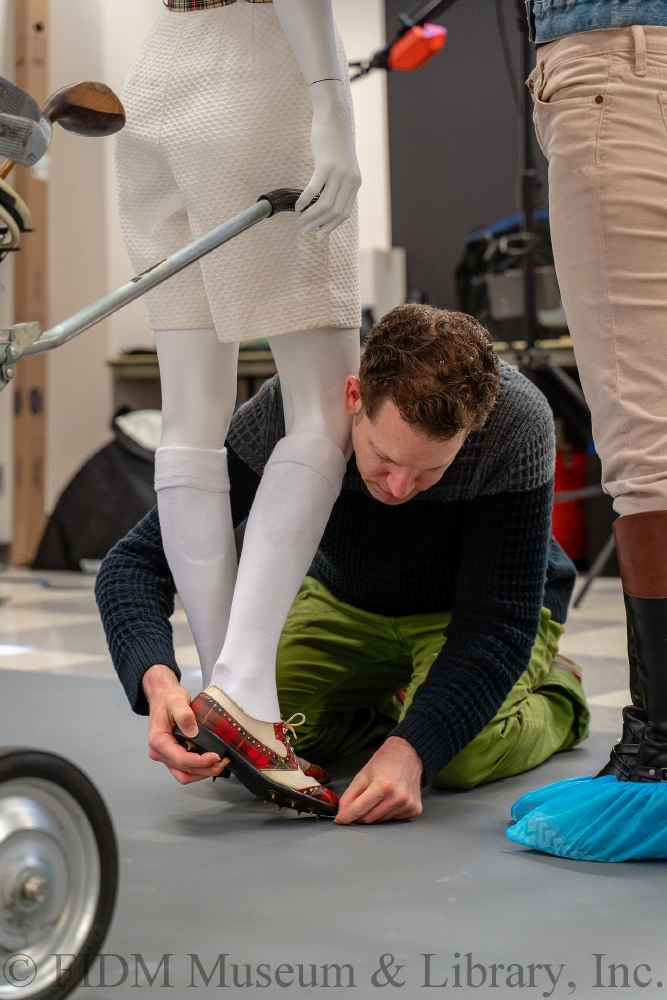 Photography for Sporting Fashion: Outdoor Girls 1800 to 1960, catalog and exhibition coming to the Museum in May 2020
Photography for Sporting Fashion: Outdoor Girls 1800 to 1960, catalog and exhibition coming to the Museum in May 2020
Where would you like to take the Museum in the next 20 years?
I would like us to continue to acquire the finest objects and keep pace with that. It’s incredibly difficult because of space limitations, and the idea of what fashion is now has changed so much. To keep up with that in a collecting sense, it’s daunting for me to know what to choose. I tend to live so much in the past and wanted to build up our older collections because we didn't have that. But now that we have a great older collection, do I need to turn and look towards the future and collect the now, or maybe five years ago? We need to continue to get all of our collections out there, we need to continue to be involved in community relations, we need to be involved more with our colleagues; of course, that all means time and money. Our Fashion Council Chair Mima and I talk about the opportunities of a foundation - establishing a foundation for the Museum that would help underwrite and provide fiscal support for the future of the Museum. Hopefully in ten or 20 years we can see more of that developed. Definitely establishing a conservation lab. We’ve got too many important pieces not to have one. Yes, we have preventative conservation, we have great storage, but we need the scientific aspect to the care of our collections. I keep pushing for it, it’s all about timing and funds. Cheers from your FIDM Museum family on twenty wonderful years Kevin!
